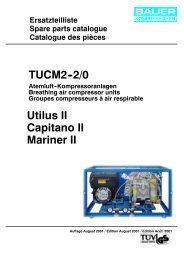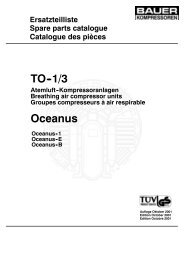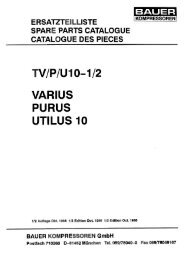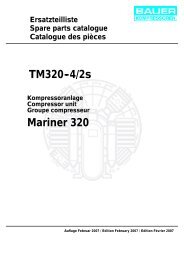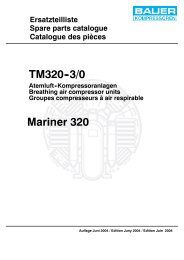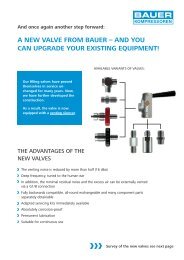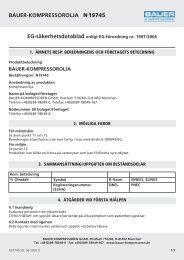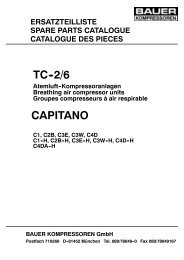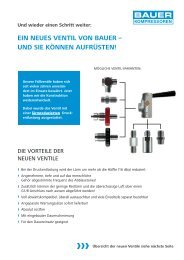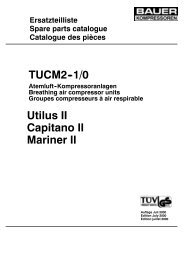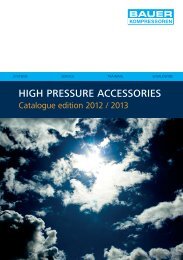Operator's Manual High Pressure Breathing Air Compressors
Operator's Manual High Pressure Breathing Air Compressors
Operator's Manual High Pressure Breathing Air Compressors
Create successful ePaper yourself
Turn your PDF publications into a flip-book with our unique Google optimized e-Paper software.
3.7. FILLING PROCEDURE<br />
3.7.1. General<br />
26<br />
Operator’s <strong>Manual</strong><br />
The filling valve connection is of the manual type and permits connection to air tanks without using tools. An O--ring is provided for<br />
self--sealing due to internal overpressure.<br />
Compressed air tank filling valves for a pressure in excess of 200 bar are standardized (DIN 477, sheet 5) and connectors for 200<br />
and 300 bar are different and cannot be mixed up.<br />
To ensure safe air tank removal after filling, the valve has an integral venting bore. Therefore always close tank valve first before<br />
closing filling valve.<br />
During filling procedure bottles will warm up due to recompression. After removing, allow to cool down, bottles may then be reconnected<br />
and topped up to the respective maximum filling pressure (max. allowed filling overpressure at 15 °C).<br />
3.7.2. Intake air quality<br />
At routine tests, CO2 values beyond the permissible values are noted from time to time. Closer investigations often show that the<br />
compressed air is taken from rooms in which one or more persons are working. At insufficient ventilation, the CO2 value in the surrounding<br />
air can increase quite fast because of the exhaling of CO2.CO2values from 1,000 to 5,000 ppmv in workrooms are not<br />
unusual (MAK--value (max. workroom concentration) is 5,000 ppmv). Another additional increase is caused by cigarette smoking,<br />
producing approx. 2g CO2 (¶ 2,000 ppmv) per cigarette. These pollutions add up to the basic pollution of approx. 400 ppmv.The technically caused excessive increase of CO2 during the filling process and the CO2 peak at taking the unit into operation. Because<br />
of the reasons stated above and for your own security, the filling of breathing air bottles is not allowed in rooms used as<br />
workrooms.<br />
3.7.3. Scavenging the compressor unit<br />
CO2 is present in the atmosphere with a natural amount of 250 -- 800 ppmV. The molecular sieve used in the purifiers for drying the<br />
breathing air is, as well as other capabilities, able to adsorb CO2 which is accumulated in the cartridge. After shut--down of the compressor,<br />
adsorbed CO2 may be desorbed again due to the partial pressure decrease. The now free CO2 then gets washed out of<br />
the cartridge when the compressor is started again.<br />
To avoid increased CO2 contents in the compressed breathing air, we recommend scavenging the compressor unit before connecting<br />
and filling the air bottles, i.e. let the compressed air escape into the open air by opening the filling valves for about 1 to 2<br />
minutes. Remove filling hose for this action, or hold the respective filling hose tightly when opening the filling valve, to avoid any uncontrolled<br />
whipping of the filling hose. See also chapter filling the bottles.<br />
3.7.4. Switch -over valve<br />
Filling panels for 2 pressure ranges (PN 200 / PN 300) and with a switch--over valve, with which it is possible to switch between two<br />
pressure ranges, can only be used for one pressure range at a time. The 200 bar side is opened by means of the shut--off valve. The<br />
300 bar filling valves remain pressurized but can only be used up to a pressure of 200 bar. It is impossible to connect 200 bar bottles<br />
to the 300 bar filling connections (right hand side).<br />
CAUTION<br />
Before switching from 300 bar to 200 bar, i.e. to the<br />
lower pressure range, it is essential to open the<br />
venting valve and to reduce the 300 bar line to at<br />
least 200 bar. Otherwise, the pressure gauge could<br />
be damaged or destroyed.<br />
WARNING<br />
Open the switch -over valve slowly in order to avoid<br />
a pressure surge! Filling hoses which are not in use<br />
must be hung in the holders on the bottom of the filling<br />
panel, so that should a filling valve be inadvertently<br />
opened, the pressurized air outstream cannot<br />
cause the hose to whip and cause serious injury.<br />
3.7.5. <strong>Pressure</strong> reducer<br />
Filling panels for 2 pressure ranges (PN 200 / PN 300) and with a pressure reducer, can be used for filling bottles simultaneously<br />
at two pressures, i.e. simultaneous filling of 200 bar and 300 bar bottles is possible!<br />
The pressure reducer used in the filling panel is adjustable to a high precision.<br />
Max. inlet pressure 420 bar<br />
Secondary pressure 0.1 to 280 bar<br />
(range of adjustment)<br />
Temperature range --10 °C to +100 °C<br />
Normal delivery 32 m 3.<br />
A 20 mm particle filter is installed at the pressure reducer inlet.



